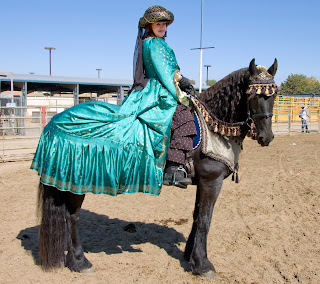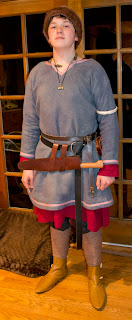 |
Queen Elizabeth 1 in stunningly embroidered
dress |
We started the Elizabethan embroidery class today with a slide show of incredible examples both from paintings and surviving pieces of embroidery. Of course, fashion followed the monarch herself. Her intricately embroidered dresses were masterworks and sometimes were so heavily jeweled that she would have to be carried, rather than walking. In this picture to the right, the embroidery depicts all sorts of wildlife, some quite realistic and others from imagination.
 |
| Botanical & natural themes in Elizabethan gold work |
 Themes for embroidery during the 16th century generally tended to coincide with what people knew: botanical and animal life. In this piece of gold-work (where the thread is wrapped with pure gold), undulating vines with leaves, flowers, caterpillars moths, and other bugs are depicted. However, Queen Elizabeth had a penchant for being one of a kind (she even had laws against others being able to wear things as grandiose as hers… like the size of their neck ruffs!)
Themes for embroidery during the 16th century generally tended to coincide with what people knew: botanical and animal life. In this piece of gold-work (where the thread is wrapped with pure gold), undulating vines with leaves, flowers, caterpillars moths, and other bugs are depicted. However, Queen Elizabeth had a penchant for being one of a kind (she even had laws against others being able to wear things as grandiose as hers… like the size of their neck ruffs!)
 |
| “I always feel like somebody’s watching me…” |
In this painting, the embroidery design covering her dress is of eyes and ears, to imply that she could see and hear all and was omniscient over her subjects. Wouldn’t that strike terror into the hearts of her court, servants, and the general populace!
On the left sleeve, a jeweled serpent wraps and entwines itself, holding a heart-shaped ruby from it’s mouth, representing the queen’s passions (the heart) being controlled by her wisdom (the serpent.)
Looking at examples from the Victoria and Albert Museum’s textile collection in London, as well as other British sources, we came to a greater understanding of the sheer magnitude of the embroidery movement during the Elizabethan era.
Other objects which I found interesting that were heavily embroidered were caskets (a type of box… not a coffin), books, and intricate gloves and mittens. Maybe more on those another time.
After whetting our appetite with amazing image, we got down to stitchwork for the rest of the day. So many stitches are able to be seen, but historians don’t always know exactly how they were done. There are often more than one way to create the same stitch. So, we’re learning many stitches, but not doing them necessarily in the same way which the were stitched in the past.
We are using authentic materials: wool, linen, and cotton for threads and fabric the most part, although some silk fabric was also used in that era. I didn’t realize that the term “crewel embroidery” means stitching with wool. Hopefully I’ll have a finished sampler or more done by the end of class tomorrow, so I can share some photos!












